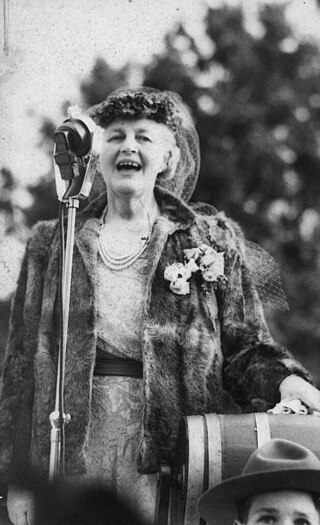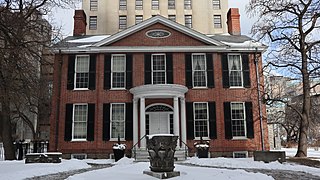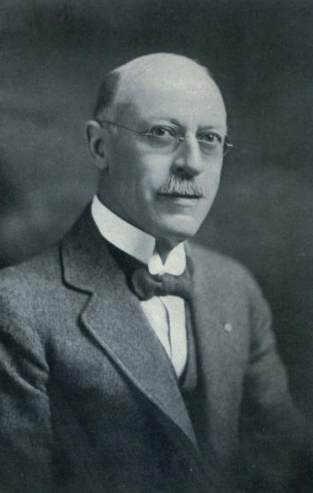
Forest Hill is a neighbourhood and former village in Midtown Toronto, Ontario, Canada, located north of Downtown Toronto. The village was amalgamated into Toronto in 1967 and the area has retained its name as a neighbourhood. Along with other neighbourhoods such as Rosedale and The Bridle Path, it is one of Toronto's wealthiest neighbourhoods, with an average income, among income recipients 15 or older in private households, of $157,600 in Forest Hill South and $89,700 in Forest Hill North, compared to the $59,250 average income in Toronto's Census Metropolitan Area and $54,450 in Canada as a whole.

The Annex is a neighbourhood in Downtown Toronto, Ontario, Canada. The traditional boundaries of the neighbourhood are north to Dupont Street, south to Bloor Street, west to Bathurst Street and east to Avenue Road. The City of Toronto recognizes a broader neighbourhood definition that includes the adjacent Seaton Village and Yorkville areas.

Spadina Museum, also known as Spadina House, is a historic mansion at 285 Spadina Road in Toronto, Ontario, which is now a historic house museum operated by the City of Toronto's Economic Development & Culture division. The museum preserves the house much as it existed and developed historically. The art, decor and architecture of the house used to reflect the contemporary styles of the 1860s through the 1930s, including Victorian, Edwardian, Arts and Crafts, Art Nouveau, Art Deco and Colonial Revival styles. The museum closed for a year for extensive interior and exterior renovations. When it re-opened to the public on October 24, 2010, it was decorated in the style of the inter-war era of the 1920s and 1930s. The estate's gardens reflect the landscape during the Austin family's occupation of the house.

Spadina Avenue is one of the most prominent streets in Toronto, Ontario, Canada. Running through the western section of downtown, the road has a very different character in different neighbourhoods.

Sir John Craig Eaton was a Canadian businessman and a member of the prominent Eaton family.

The Eaton family is a Canadian family of Scottish-Irish Methodist origin. Established in Toronto, the family dynasty began in 1869 when Timothy Eaton (1834–1907) founded Eaton's, which became a national chain of department stores. At its height, the family's net worth was around $2 billion. Although the Eaton's department store chain went bankrupt in 1999, the family still holds considerable wealth.

Sarah Evelyn Florence "Flora" Eaton, Lady Eaton, was a Canadian socialite, philanthropist and nurse. As the wife of Sir John Craig Eaton, who inherited the Eaton's department store business, she was a member and later matriarch of the prominent Eaton family.

John David Eaton was a Canadian businessman and a member of the Eaton family. From 1942–1969, he was president of Eaton's, the department store chain his grandfather, Timothy Eaton, founded.

Eaton Hall is a large house in King City, Ontario, Canada, built in the Norman style for Lady Eaton in 1938–39 on a 700-acre (2.8 km²) parcel of land. Lady Eaton and her husband, Sir John Craig Eaton acquired the land in 1920 and 1922 on recommendation from their friend Sir Henry Pellatt, who owned the nearby Mary Lake property. Lady Eaton moved into Eaton Hall three years after selling her city mansion, Ardwold. The house is adjacent to a body of water named Lake Jonda, and nestled within the temperate forests of King Township. Upon completion, it contained 72 rooms. It became a beloved gathering place for the Eaton Family, owners of the Eaton's department stores based in Toronto.

Campbell House is an 1822 heritage house and museum in downtown Toronto, Ontario, Canada. It was built for Upper Canada Chief Justice Sir William Campbell and his wife Hannah. The home was designed for entertaining and comfort, and constructed at a time when the Campbells were socially and economically established and their children had grown to adulthood. The house is one of the few remaining examples of Georgian architecture left in Toronto and is constructed in a style in vogue during the late Georgian era known as Palladian architecture.

Timothy Eaton Memorial Church is a church located at 230 St. Clair Avenue West in Forest Hill, Toronto, Ontario. Originally Methodist, since 1925, it has belonged to the United Church of Canada. The church is named in memory of Timothy Eaton, founder of the Eaton's department store chain, whose family donated the land the church sits on. It was completed in 1915 in the Gothic Revival style by Wickson & Gregg.

There are two castings of the well-known statue of Timothy Eaton, the famous Canadian retailer: one in Toronto, Ontario, the other in Winnipeg, Manitoba.
Since its founding in 1829, Upper Canada College (UCC), in Toronto, Ontario, Canada, has occupied a number of sites and various structures on those sites. The school campus has always held a relatively prominent place within the city.
The Marylake Augustinian Monastery, also known as Marylake Monastery, Marylake Shrine, or simply Marylake, is an Augustinian monastery in King City, Ontario, Canada. The campus is nearly 1,000 acres (4.0 km2), residing on Keele Street, just north of 15th Sideroad (Bloomington). It is part of the Province of Saint Joseph, the Canadian province of Augustinians which operates under the jurisdiction of the Chicago-based Province of Our Mother of Good Counsel.

Casa Loma is a Gothic Revival castle-style mansion and garden in midtown Toronto, Ontario, Canada, that is now a historic house museum and landmark. It was constructed from 1911 to 1914 as a residence for financier Sir Henry Pellatt. The architect was E. J. Lennox, who designed several other city landmarks. Casa Loma sits at an elevation of 140 metres (460 ft) above sea level, 66 metres (217 ft) above Lake Ontario.

South Hill is a neighbourhood in Toronto, Ontario, Canada. It is located north of downtown and covers the area west of Avenue Road, south of St. Clair Avenue, east of Spadina Road, and north of the Canadian Pacific railway tracks. The area is dominated by the steep hill of the Davenport Road escarpment. The Nordheimer Ravine also cuts through the area, which is surrounded by Sir Winston Churchill Park. This park covers the northwestern portion of South Hill.

Grange Park is a neighbourhood in downtown Toronto, Ontario, Canada. It is bounded on the west by Spadina Avenue, on the north by College Street, on the east by University Avenue and on the south by Queen Street West. It is within the 'Kensington-Chinatown' planning neighbourhood of the City of Toronto. Its name is derived from the Grange Park public park. The commercial businesses of Chinatown extend within this neighbourhood.

The Esplanade is an east-west street along the central waterfront of Toronto, Ontario, Canada. This neighbourhood consists of generally low-rise and mid-rise housing - condominiums, public housing, cooperatives and some town homes between Jarvis and Parliament Streets south of Front Street. The stretch between Scott Street and Market Street is a popular restaurant area.

Alexander Frank Wickson was a prominent Toronto architect who was responsible for the design of numerous buildings, including Timothy Eaton Memorial Church, the IOOF Hall (Toronto) and the "Ardwold" mansion for the Eaton family. He was president of the Ontario Association of Architects in 1900 and of the Royal Architectural Institute of Canada from 1918 to 1920.
Signy Hildur Eaton was a Canadian socialite, art collector and philanthropist. She was married to John David Eaton, of the Eaton family of Toronto.
















